A gondola is a traditional Venetian rowing boat, best known today for transporting tourists.
Contents
Gondola may also refer to:
A gondola is a traditional Venetian rowing boat, best known today for transporting tourists.
Gondola may also refer to:

An aircraft is a vehicle that is able to fly by gaining support from the air. It counters the force of gravity by using either static lift or the dynamic lift of an airfoil, or in a few cases the downward thrust from jet engines. Common examples of aircraft include airplanes, helicopters, airships, gliders, paramotors, and hot air balloons.

A blimp, or non-rigid airship, is an airship (dirigible) without an internal structural framework or a keel. Unlike semi-rigid and rigid airships, blimps rely on the pressure of the lifting gas inside the envelope and the strength of the envelope itself to maintain their shape.

An airship or dirigible balloon is a type of aerostat or lighter-than-air aircraft that can navigate through the air under its own power. Aerostats gain their lift from a lifting gas that is less dense than the surrounding air.

An aerial tramway, sky tram,cable car, ropeway, aerial tram, telepherique, or seilbahn is a type of aerial lift which uses one or two stationary ropes for support while a third moving rope provides propulsion. With this form of lift, the grip of an aerial tramway cabin is fixed onto the propulsion rope and cannot be decoupled from it during operations. In comparison to gondola lifts, aerial tramways generally provide lower line capacities and higher wait times.
Cable car most commonly refers to the following cable transportation systems:

An axle or axletree is a central shaft for a rotating wheel or gear. On wheeled vehicles, the axle may be fixed to the wheels, rotating with them, or fixed to the vehicle, with the wheels rotating around the axle. In the former case, bearings or bushings are provided at the mounting points where the axle is supported. In the latter case, a bearing or bushing sits inside a central hole in the wheel to allow the wheel or gear to rotate around the axle. Sometimes, especially on bicycles, the latter type of axle is referred to as a spindle.

A gondola lift is a means of cable transport and type of aerial lift which is supported and propelled by cables from above. It consists of a loop of steel wire rope that is strung between two stations, sometimes over intermediate supporting towers. The cable is driven by a bullwheel in a terminal, which is typically connected to an engine or electric motor. It is often considered a continuous system since it features a haul rope which continuously moves and circulates around two terminal stations. In contrast, an aerial tramway operates solely with fixed grips and simply shuttles back and forth between two end terminals.
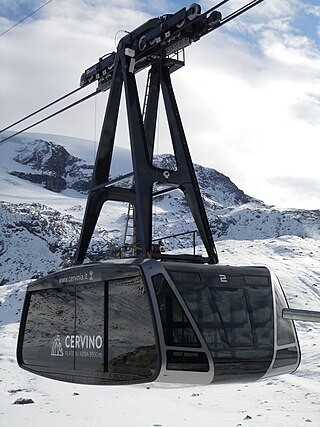
An aerial lift, also known as a cable car or ropeway, is a means of cable transport in which cabins, cars, gondolas, or open chairs are hauled above the ground by means of one or more cables. Aerial lift systems are frequently employed in a mountainous territory where roads are relatively difficult to build and use, and have seen extensive use in mining. Aerial lift systems are relatively easy to move and have been used to cross rivers and ravines. In more recent times, the cost-effectiveness and flexibility of aerial lifts have seen an increase of gondola lift being integrated into urban public transport systems.

An aerostat is a lighter-than-air aircraft that gains its lift through the use of a buoyant gas. Aerostats include unpowered balloons and powered airships. A balloon may be free-flying or tethered. The average density of the craft is lower than the density of atmospheric air, because its main component is one or more gasbags, a lightweight skin containing a lifting gas to provide buoyancy, to which other components such as a gondola containing equipment or people are attached. Especially with airships, the gasbags are often protected by an outer envelope.
Ropeway may refer to:

A suspended roller coaster is a type of steel roller coaster in which the car hangs from the bottom of the rolling stock by a pivoting fulcrum or hinge assembly. This allows the car and riders to swing side to side as the train races along the track. Due to the swing designs, these roller coasters cannot invert riders.
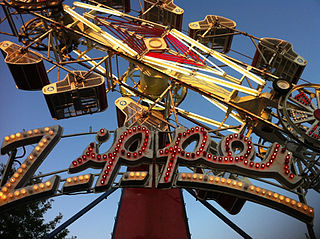
The Zipper is an amusement ride invented by Joseph Brown under Chance Rides in 1968. Popular at carnivals and amusement parks in the United States, Canada, Australia, Mexico and New Zealand, it features strong vertical G-forces, numerous spins, and a noted sense of unpredictability. Chance Rides has manufactured more than 200 units since the ride's debut.
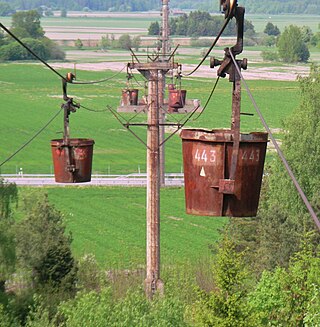
A material ropeway, ropeway conveyor is a subtype of gondola lift, from which containers for goods rather than passenger cars are suspended.
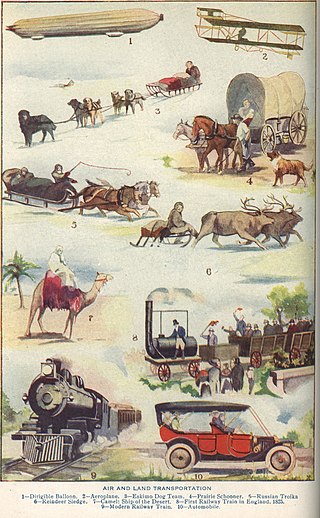
The following outline is provided as an overview of and topical guide to transport:

The tricable gondola lift, also known as the 3S gondola lift, is a cable car system that was developed by the Swiss company Von Roll transport systems in Thun to unite the benefits of a gondola lift with those of a reversible cable car system. '3S' is an abbreviation of the German word dreiseil, meaning 'tricable'.
A mooring mast, or mooring tower, is a structure designed to allow for the docking of an airship outside of an airship hangar or similar structure. More specifically, a mooring mast is a mast or tower that contains a fitting on its top that allows for the bow of the airship to attach its mooring line to the structure. When it is not necessary or convenient to put an airship into its hangar between flights, airships can be moored on the surface of land or water, in the air to one or more wires, or to a mooring mast. After their development mooring masts became the standard approach to mooring airships as considerable manhandling was avoided.

Ballast is material that is used to provide stability to a vehicle or structure. Ballast, other than cargo, may be placed in a vehicle, often a ship or the gondola of a balloon or airship, to provide stability. A compartment within a boat, ship, submarine, or other floating structure that holds water is called a ballast tank. Water should move in and out from the ballast tank to balance the ship. In a vessel that travels on the water, the ballast will remain below the water level, to counteract the effects of weight above the water level. The ballast may be redistributed in the vessel or disposed of altogether to change its effects on the movement of the vessel.

LZ 120 Bodensee was a passenger-carrying airship built by Zeppelin Luftschiffbau in 1919 to operate a passenger service between Berlin and Friedrichshafen. It was later handed over to the Italian Navy as war reparations in place of airships that had been sabotaged by their crews and renamed Esperia. A sister-ship, LZ 121 Nordstern, was built in 1920: it was handed over to France and renamed Méditerranée.
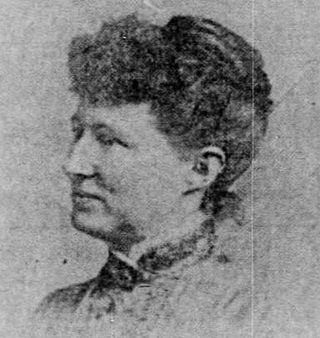
Mary Myers was an American professional balloonist and aeronautical inventor, better known as "Carlotta, the Lady Aeronaut." She was the first American woman to fly her own lighter-than-air passenger balloon solo and set several records for balloon flights.
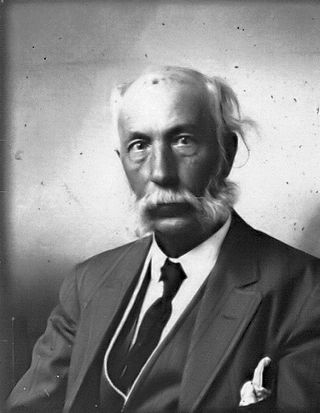
Carl Edgar Myers was an American businessman, scientist, inventor, meteorologist, balloonist, and aeronautical engineer. He invented many types of hydrogen balloon airships and related equipment. His business of making passenger airshipballoons and instrument balloons at his "balloon farm" was well known throughout the United States in the late nineteenth and early twentieth centuries. He invented a machine for varnishing fabric that would make it impervious to hydrogen so that the finished product could be made into large envelopes for lighter-than-air balloons.